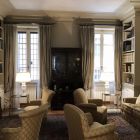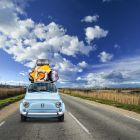Sitting on the west side of Maputo Bay overlooking the Indian Ocean, Maputo is divided into two distinct parts: the colonial Cidade cimento, occupying the areas closest to the sea, and the indigenous Canio, stretching further inland. The former is inhabited by middle- and high-income Mozambicans and the large expatriate community, while the latter is home to the local population. Since the end of the post-independence conflict (1975-1992, although peace was only properly established in 1994) there has been an increase in both reasonably priced and exclusive accommodation consisting of both apartments and detached houses, usually on two floors which is spacious by European standards. Traffic in the city is heavy and the roads are generally poor. Buses are in short supply and the local population gets around on foot or by the semi-official chapas (white minibuses displaying the number and destination on the front), which are very cheap but not always safe. Expats travel mostly by taxi or buy their own car. Maputo is relatively safe and offers a good range of leisure and sports activities, beautiful beaches and a pleasant climate. It also has an interesting cultural life, with film, music, drama, dance, exhibitions and events organised by the numerous humanitarian agencies or by the university. There are several international schools and private clinics, although rich Mozambicans and most expats prefer to go to Nelspruit in neighbouring South Africa for treatment if they are seriously ill. Portuguese and some English are spoken in the Cidade cimento, while one is more likely to hear MaXangana or MaRonga, two of the many local tongues, in the Canio.
Alto Ma
Alto Ma stretches along the end of Avenida 24 de Julho and Avenida Eduardo Mondlane between the Cidade cimento and the Canio. It hosts the parliament building (Assembleia da Republica), constructed by the Chinese in 1997, and the 1975 Museum of the Revolution (Museu de Revoluo), one of only two museums devoted to Mozambican history in the country (the other is the ethno-anthropological museum in Nampula, Mozambiques third city, 2,500 km north of Maputo). Once home to the citys Indian immigrant community, Alto Ma is a lively commercial area; at the end of Avenida Eduardo Mondlane, beyond the statue of Eduardo Mondlane (the first leader of the revolutionary party Frente Nacional de Libertao de Moambique, or Frelimo, now in government), is the Xima, one of the most popular live music disco pubs in the city. The open-air market on Largo Joo Albasini, a few minutes walk from the statue of Eduardo Mondlane, sells good quality local and imported goods such as fruit, vegetables, meat and clothes more cheaply than supermarkets. Between Alto Ma and Xipamanine, one of the old Canio areas, is the unofficial Xipamanine market, one of the oldest and largest in Maputo, selling second-hand clothes, chickens, cows, talismans and also items found at the official market but at lower prices. Housing is a mix of apartments in two-ten storey buildings and poorly kept detached houses dating from the 1930s and 1940s.
Baixa
Daily life in this busy commercial area revolves around the harbour and the central fruit and vegetable market, which has just been rebuilt following a fire in July 2005. At night there is a faint echo of what was known as the nights of the African Paris, when the golden youth of the 1960s flocked to the famous pubs and disco bars. Many of these have appeared in the work of the famous Mozambican photographer Ricardo Rangel, an intellectual and jazz lover who recently opened a music bar, Chez Rangel, inside the railway station in Praa dos Trabalhadores in the heart of the Baixa; the pictures form part of an exhibition in the bar illustrating the transformation of the colonial city of Loureno Marques to Maputo, the capital of the independent republic of Mozambique.
The railway station is a legacy of the colonial era; a large green building dating from the turn of the 20th century, it is now largely unused (only two freight trains leave each day, one for South Africa and the other in the direction of Zimbabwe, stopping short of the border) but it is clean and well guarded and the two ancient locomotives on display in the entrance, the dome designed by the French engineer Gustave Eiffel and the marble floors draw a steady stream of tourists. Nearby on Avenida Samora Machel stands the famous Casa do Ferro, also by Eiffel, a house made exclusively of metal plates for the Portuguese governor of Mozambique.
Most of the earliest buildings in the Baixa have been pulled down or are in ruins. However, the area around Fortaleza square opposite the commercial port, which marks the site of the original Portuguese settlement, is now being partly restored and rebuilt. The square hosts a large arts and crafts market on Saturday mornings.
In the nearby Praa da Independna stands the Centro Cultural Franco Mocambicano, one of the most famous restored buildings in the Baixa. The Centro is a bar, cinema, theatre, cultural centre, exhibition space, garden and more besides. The Roman Catholic cathedral of Our Lady of Fatima and the city hall are also in this square. There are two parks in the Baixa, the botanical gardens, Jardins Tounduru, and the Circuito deportivo opposite the ministry of youth and sport.
Housing is almost exclusively in apartments in five-ten storey buildings around Praa da Independna, Avenida Vladimir Lenine and Avenida Ho Chi Min, near the Tiger Centre shopping centre. At night Baixa is an area of petty crime.
Catembe
Catembe is a small settlement on the far side of Maputo Bay, 15 minutes by ferry from the Baixa. Passenger boats leave every 10 minutes and the return ticket costs 10,000 meticais; car ferries depart every half hour. Otherwise, Catembe can be reached by driving around the bay, but the journey takes an hour. There are a few restaurants, bars and disco clubs and the Mirasol Hotel with an outstanding terrace overlooking the sea; fishermen sell their catch directly on the beach, which offers incredible views of the Maputo skyline. Many of the colonial villas that were abandoned after independence are now being restored, and Catembe is a growing tourist attraction and as a place where expats and high-middle income Mozambicans spend their weekends and holidays. The availability of cheap land will probably attract new development before long. The local inhabitants live along the dirt road leading to the Reserva dos Elefantes (elephant reserve); they are mainly subsistence farmers and fishers who sell any surplus in Maputo.
Central/Malhangalene
Located northwest of Polana and Sommerschield in the direction of the commercial Baixa area, Central and Malhangalene have fewer trees and poorer roads than their more upmarket neighbours but they are still popular among expats because they have good quality accommodation and all kinds of services (clinics, transport, restaurants, shops, bars, travel agencies). In Central housing is a mix of apartments in eight/ten-floor concrete structures, especially along Avenida 24 de Julho, Avenida Eduardo Mondlane and Avenida Mao Tze Tung, and two-storey early 20th century houses along the top of the escarpment facing the sea. Malhangalene, further inland, has three- or four-storey walk-up detached brick buildings with tiled roofs and large balconies and others made of concrete with flat roofs or, occasionally, with tiled roofs. Two of Maputos four mosques are located in these areas, one in Avenida Eduardo Mondlane and the other tucked away in Rua da Alegria. Muslims make up one third of the citys 1.2 million people (official census figures; estimates put the real figure at closer to 2 million). Central also has one of the better private clinics in town, the Clinica 222 (Avenida 24 de Julho 821, tel. 00258 21 432736). In Malhangalene there is a small but well stocked market, Mercado Janet, selling everything from clothes to fruit, from saucepans to hair extensions; there are also tailors using old Singer machines to make and repair clothes.
Coop
Coop, east of Malhangalene, is the old Bairro Militar, or colonial military quarter, built to include barracks, shooting ranges, night and sports clubs for the officers and soldiers. Today it is a middle-class residential area and the location of the university campus. It is bordered to the southeast by Avenida Vladimir Lenine, one of the longest roads in the city, and is bisected by Avenida Kenneth Kaunda, where most embassies and United Nations agencies are based. (By contrast humanitarian non-governmental organisations are scattered across the city.) Coop boasts two of the most famous buildings in Maputo, designed by the Portuguese architect Pancho Guedes: O leo que ri (The smiling lion) and O drago (The drake). They represent an attempt to adapt the international modernism of the 1950s and 1960s to the southern African context, drawing heavily on traditional African forms. Housing in this area is mostly in apartments in simple two- or three-storey buildings except around the university campus, where professors live in attractive detached homes. The Military Hospital in Coop, which is also open to civilians, is considered one of the best hospitals in town. The area has some large and relatively well stocked shops such as Vosso Supermercado and Luz, as well as the largest Chinese restaurant in Maputo, in the Chinese building in Avenida Vladimir Lenine. With the exception of the main roads, the area is poorly served by public transport.
Inhaca Island
Inhaca is the largest island in Maputo Bay about 37 km off the coast with a nature reserve, the small village of Vila de Inhaca and beautiful beaches. It takes 15 minutes to get there by plane or an hour and a half by ferry. It is also possible to ask fishermen for a lift, but the crossing can take three-four hours, and takes place at night. However, is a rather exiting experience since the trip ends at sunrise in front of the magnificent beach of the Farol, the lighthouse. On the Maputo side the island has a number of beaches, the Inhaca Island Lodge Hotel, some lodges and the Institute of Marine Biology (Biologia Marina), part of the biology faculty of the Universidade Eduardo Mondlane. On the other side, there are no tourist facilities and the beaches are untouched. There is a small market at the entrance to Vila de Inhaca and a shop selling basics such as mineral water, beans, rice, sunflower oil and tissues. There are a few bars and restaurants, such as the Carioca, owned by Armando, a Portuguese man who speaks almost all European languages and is always smiling, and the Restaurant Lucas. In addition to the local indigenous population, the island is also home to administrators and researchers at the Institute of Marine Biology, students from Maputo and other African and international universities, and rich people (mostly expats) in search of a relaxing and isolated place to spend the week end. There are no high-rise buildings on the island; all houses are one, or at most two stories and have their own garden.
Maxaquene
Originally referring to the area around the Ponta Vermelha promontory, after independence Maxaquene came to denote the area at the end of Avenida Kenneth Kaunda in the northern part of the city towards the airport. It is a fairly poor area, with small, one- and two-storey buildings with flat roofs, and few tarmac roads. However, the South African-owned Shoprite, the largest supermarket in town, is a magnet for expats; located at the airport end of Avenida Joaquim Chissano, the store stocks local and imported goods although prices for the latter are high, roughly corresponding to those in a middle-sized European capital. Opposite Shoprite is the Corrida in Praa de Toros, the setting for a scene in Sydney Pollacks 2005 film The Interpreter, and now in disuse. The area is largely inhabited by immigrants from other parts of the country who have found employment in Maputo as domestic workers, street sellers or skilled labourers and can afford the cost of living in the Cidade cimento.
Nova Sommerschield/Triunfo
In the last five years a number of new villas and compounds have been built from Sommerschield down to the Costa do Sol beach, creating the new luxury areas of Nova Sommerschield and Triunfo for expats and high-income Mozambicans looking for a villa with a garden and possibly a swimming pool near the sea and away from the noise and traffic of the city centre. Meanwhile, the original residents with their palhotas (houses made of straw, wood and earth) and machambas (vegetable plots) have been pushed out. The areas boast the Mercado do Peixe, or fish market, where fresh sea food can be cooked on the spot at one of the many kiosks. The Restaurant Costa do Sol is another draw; high and middle-income families come here on weekends to eat fish at low prices in an attractive mangrove and beach environment. Nova Sommerschield and Triunfo also have two large South African shopping centres, Game and Mares. There are French and Portuguese schools in Triunfo but other services supermarkets, health and schooling are in nearby Sommerschield and Polana.
Polana/Sommerschield
Following independence from Portugal in 1975 and the subsequent reorganisation of urban areas, Polana, due north of the Ponta Vermelha promontory, together with Sommerschield to the northeast, became the de facto city centre. Ten-fifteen floor buildings blend in among two-storey detached houses hidden beneath blooming acacias, frangipani and bougainvillea. Houses are made of concrete and/or red bricks; they date from the 1930s and 1940s, have tiled roofs and are painted yellow, old rose pink or white a departure from colonial times, when all houses had to be white. The areas contain among other things the modern Polana Shopping Centre, the historical Hotel Polana, built in the 1920s, the Cinema Xenon, a number of restaurants, taxi ranks, well-stocked farmacies and the most efficient and exclusive clinics in the country. These include the Clinica da Sommerchield (Rua Pereira Lago 52, tel. 00258 21 49428), considered the best in town. Polana is also home to English and international schools. Chapas run along Avenida Julius Nyerere and its perpendiculars, Avenida 24 de Julho, Avenida Eduardo Mondlane and Avenida Mao Tze Tung, but otherwise public transport services in these areas are poor. The roads are in relatively good condition and there is on-street parking for private vehicles. Cars can be minded by a guarda for a small fee.


















